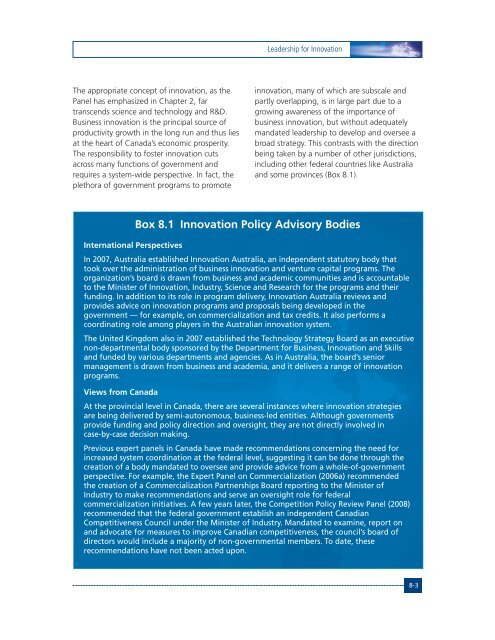Innovation Canada: A Call to Action
Innovation Canada: A Call to Action
Innovation Canada: A Call to Action
You also want an ePaper? Increase the reach of your titles
YUMPU automatically turns print PDFs into web optimized ePapers that Google loves.
Leadership for <strong>Innovation</strong>The appropriate concept of innovation, as thePanel has emphasized in Chapter 2, fartranscends science and technology and R&D.Business innovation is the principal source ofproductivity growth in the long run and thus liesat the heart of <strong>Canada</strong>’s economic prosperity.The responsibility <strong>to</strong> foster innovation cutsacross many functions of government andrequires a system-wide perspective. In fact, theplethora of government programs <strong>to</strong> promoteinnovation, many of which are subscale andpartly overlapping, is in large part due <strong>to</strong> agrowing awareness of the importance ofbusiness innovation, but without adequatelymandated leadership <strong>to</strong> develop and oversee abroad strategy. This contrasts with the directionbeing taken by a number of other jurisdictions,including other federal countries like Australiaand some provinces (Box 8.1).International PerspectivesBox 8.1 <strong>Innovation</strong> Policy Advisory BodiesIn 2007, Australia established <strong>Innovation</strong> Australia, an independent statu<strong>to</strong>ry body that<strong>to</strong>ok over the administration of business innovation and venture capital programs. Theorganization’s board is drawn from business and academic communities and is accountable<strong>to</strong> the Minister of <strong>Innovation</strong>, Industry, Science and Research for the programs and theirfunding. In addition <strong>to</strong> its role in program delivery, <strong>Innovation</strong> Australia reviews andprovides advice on innovation programs and proposals being developed in thegovernment — for example, on commercialization and tax credits. It also performs acoordinating role among players in the Australian innovation system.The United Kingdom also in 2007 established the Technology Strategy Board as an executivenon-departmental body sponsored by the Department for Business, <strong>Innovation</strong> and Skillsand funded by various departments and agencies. As in Australia, the board’s seniormanagement is drawn from business and academia, and it delivers a range of innovationprograms.Views from <strong>Canada</strong>At the provincial level in <strong>Canada</strong>, there are several instances where innovation strategiesare being delivered by semi-au<strong>to</strong>nomous, business-led entities. Although governmentsprovide funding and policy direction and oversight, they are not directly involved incase-by-case decision making.Previous expert panels in <strong>Canada</strong> have made recommendations concerning the need forincreased system coordination at the federal level, suggesting it can be done through thecreation of a body mandated <strong>to</strong> oversee and provide advice from a whole-of-governmentperspective. For example, the Expert Panel on Commercialization (2006a) recommendedthe creation of a Commercialization Partnerships Board reporting <strong>to</strong> the Minister ofIndustry <strong>to</strong> make recommendations and serve an oversight role for federalcommercialization initiatives. A few years later, the Competition Policy Review Panel (2008)recommended that the federal government establish an independent CanadianCompetitiveness Council under the Minister of Industry. Mandated <strong>to</strong> examine, report onand advocate for measures <strong>to</strong> improve Canadian competitiveness, the council’s board ofdirec<strong>to</strong>rs would include a majority of non-governmental members. To date, theserecommendations have not been acted upon.8-3
















